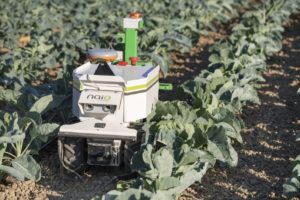Nov 17, 2022
Organic growers weigh in on agricultural robots
A pair of Michigan State University (MSU) associates interviewed growers primarily from Michigan (along with one from Ohio and another from Maryland) to determine what their perceptions and attitudes were about agricultural robots.
Fourteen interviews were conducted over the winter and spring with small organic vegetable growers with some cut flower growers also included.

Doug Bessette, assistant professor with MSU’s Department of Community Sustainability, reported on the questionnaire findings during the Mechanical Weed Control Field Day. Bessette partnered with Dan Brainard, a professor in the Department of Agriculture who works closely with Michigan vegetable growers.
The interview subjects were small operators with an average of 17 acres, but most had two to 10 acres of vegetables, either certified organic or practicing organic.
Growers reported a lack of knowledge and experience with agbots, and most were only mildly to moderately interested in using them.
Many of the growers were asked about the Naio Oz, a compact robot for small farms. Bessette said the majority compared the agbot cost to how much labor they could replace with it.
“We changed individual aspects of the robot,” Bessette said. The original robot doesn’t do within-row weeding, and Bessette asked if they would be interested if the agbot could do in-row weeding of six inches or more. Many wanted greater precision of three to four inches but weren’t interested in more speed.
A scenario of the agbot returning autonomously to fixed points on the farm for transporting tools, produce or equipment, excited the respondents.
Growers were asked about data collection, with the agbot gathering data about soil moisture, pests or plant health. They were excited, said Bessette, but had concerns with data security. “Many of them were already collecting data and wondered if they would have to check the robot’s data with their own data afterward.”
The questioners then asked about continuous operation – if it could operate continuously for 12 hours and return to a charging station autonomously. Respondents would be willing to pay a little more for that.
One question focused on the agbot potentially spanning multiple rows with high clearance. A majority of growers were interested. Some said they would rather have better precision within row weeding.
Respondents were worried about how their customers perceive these technologies. “One grower imagined the situation where their customer is driving past and sees a robot out on the farm. They didn’t know how that would affect their customer base. Would it make their customers concerned or would they be excited about that?” said Bessette.
There was also concern about viability of health and long- term food production. Who will pass this knowledge on to their children or future farmers? If everything is mechanized, who retains that knowledge and passes it on to the next generation of farmers?
Despite the reservations, there was abundant concern regarding the availability and cost of agricultural workers.
“A lot of these growers are in areas where it’s very difficult to get good labor or have people come back to the farm every season,” Bessette said. And therefore, they were excited about the opportunity to have robots on the farm that might reduce labor costs or the headaches of trying to find labor.






